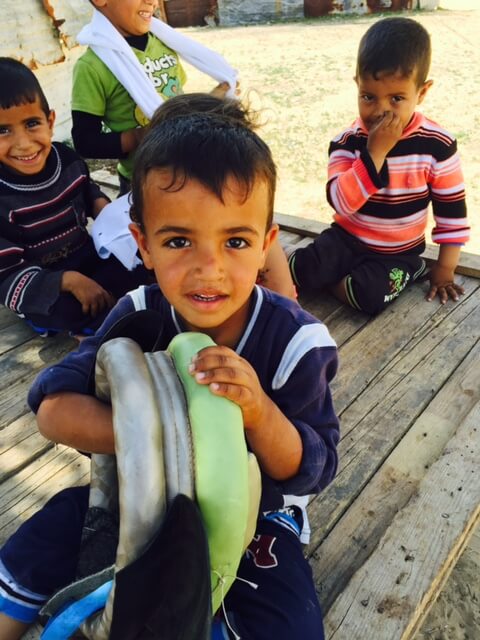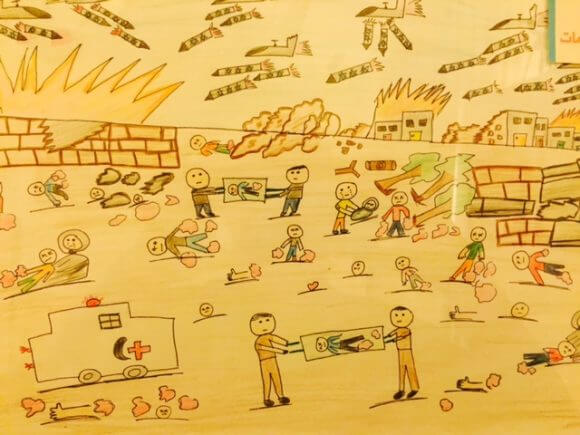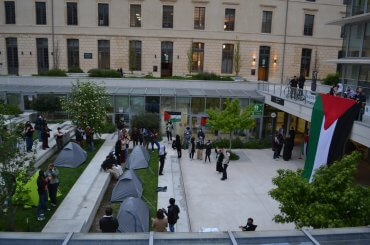“Planting hope is our main duty.”
So declared Dr. Yasser Abu Jamei, the head of the Gaza Community Mental Health Program (GCMHP), during his April 19th keynote address to the 800 people who attended the organization’s 6th International ‘Mental Health and Human Rights’ Conference in Gaza City.
This is a tall order in the Gaza Strip’s crushing conditions. But Dr. Abu Jamei – who lost 28 members of his extended family in a single missile strike during Israel’s 2014 military onslaught – is determined to build on the legacy of the late Dr. Eyad el Sarraj, who founded the GCMHP in 1990 to instill hope and heal the spirit of a people who were exposed to violence and the loss of freedom and human rights on a daily basis.
Planning an international conference in the locked down Gaza Strip was itself an exercise in optimism. For nearly a decade Israel has imposed a devastating chokehold on the territory, subjecting its 1.8 million inhabitants to collective punishment for Hamas’ victory in the 2006 legislative elections and its rout of US-backed Fatah forces the following year. Internationals, other Palestinians and Israelis were blocked from entering Gaza for the 5th International GCMHP Conference held in October 2008, and had to participate via tenuous video-link from Ramallah.
This year, German efforts secured Israeli permits for the entry of just over a dozen Europeans and Americans, an accomplishment presented by conference organizers as a harbinger of the day when Gaza’s intense isolation would be at an end. We were given a warm – even joyful – reception, as if our presence was in itself life-giving oxygen from the outside world.
The world inside Gaza was grimly portrayed in an exhibit of children’s drawings of the machinery of death, compiled by GCMHP. As Jeff Halper details in his 2015 book, War Against the People: Israel, the Palestinians and Global Pacification, Israel has profited greatly from the sale of weapons that are ‘battle-tested’ in the Gaza Strip. In the process, Gaza has been turned into a kind of lab to find the breaking point of human beings.
The presentations made at the GCMHP conference took stock of the damage that has been done to individual psyches and the collective social fabric, focusing on the impact on children of three military onslaughts in six years, the psychological stress imposed by the lack of freedom of movement, mass unemployment and current political realities, the upsurge of depression, suicide and domestic violence. While various forms of treatment were evaluated, the vital connection forged by the GCMHP between mental health and human rights was never far from the discussion.
Who could possibly think that psychological well-being could withstand so many decades of unrelenting violence, killings, mass arrests, torture, closure, the destruction of homes and livelihoods and the absence of all the freedoms that are taken for granted by the Western world? And how could the mental health needs of Palestinians be fully met without a social, economic and political transformation, beginning with an end to Israel’s dehumanizing occupation and siege?
Anger builds as reconstruction lags

In Gaza’s streets much of the rubble has finally been hauled away, leaving large bare patches of sand in otherwise densely-packed neighborhoods.
The effort to repair roads, build a thousand homes and replace some of the 73 mosques that were completely destroyed by Israel’s ‘Operation Protective Edge” has been undertaken by Qatar, the site of the October 2014 “Reconstructing Gaza’ conference at which donors pledged $5.4 billon. However, less than half of that amount has been delivered, with Qatar and other Gulf countries failing to honor their pledges.
The shortage of funds is only part of the explanation for the agonizingly slow rate of rebuilding. The failure to form a working ‘unity government’ that transcends the calamitous Fatah-Hamas rift has bred deep resentments and produced administrative confusion and gridlock.
The ‘Gaza Reconstruction Mechanism’ (GRM), agreed to by the Palestinian Authority and Israel, is designed to keep any materials that might have a ‘dual use’ (such as for houses and tunnel construction) out of the hands of the Hamas government. GRM requires cumbersome bureaucratic hoops for pre-approval and the monitoring of how materials are used. Twice in April Israel barred the import of cement, alleging that some of it was being transferred to a Hamas official and could be used to build tunnels.
According to an April 2016 report by the UN Office for the Coordination of Humanitarian Affairs, (OCHA), only 3,000 damaged dwellings have been made habitable out of the 18,000 homes that OCHA estimates were entirely destroyed or severely damaged. Some estimates for the number homes destroyed during the war are far higher.
Of the 500,000 Gazans who fled from their homes in the summer of 2014 some 90,000 people are still displaced, and frustration is rising.
Anger was palpable when we visited Shuja’yya in the eastern part of Gaza City, home to 100,000 people. A surveillance balloon marking the border with Israel was visible a kilometer away, a persistent reminder of the cause of their misery.
On July 20, 2014 more than 60 people were killed there when the neighborhood was attacked by F16s, tanks, drones and mortar fire, and buildings were pulverized by one hundred one-ton bombs.
The blasted, burned out buildings in which some families are now living have no walls to keep children from falling to the rubble below. Fadwa, a young mother with a three-year-old daughter, told us how she took refuge in a school just before their family’s 14-room house was half destroyed by F16 missiles. No warning was given.
Now two families – seven people in all – share the only four rooms that can be inhabited. Fadwa’s daughter has twice fallen from a ledge three stories high to the ground below. Her husband is unemployed.
Her 35-year-old relative Namer, a father of two who is also unemployed, recounted how they applied for aid to the UN and all the agencies they could think of, but nothing was forthcoming, not even an adequate water container. They have to ask neighbors for water and store it in a battered plastic barrel. They have no electricity and no cooking gas, and must scavenge destroyed houses for wood in order to cook food.
“We’ve talked too much and it is all in vain,” Namer told us. “They said they were find a solution but nothing happens. Just promises.”
We were accompanied by Anas, a 21-year-old university student who grew up in Shuja’yya, and told us that there are many streets in the town which we cannot visit because “there are so many people who are so angry that they won’t welcome us.”
From what we witnessed in Shuja’yya and other areas where people are still living in the ruins of leveled apartment buildings, that anger is understandable. Not only is reconstruction dismally slow, but it also has failed to provide a significant number of desperately needed jobs, leaving Gaza struggling with a nearly 50 percent unemployment rate.
Unliveable Gaza?

In 2012 an UNRWA report warned that the water, electricity and economic crisis in the Gaza Strip could render it “unliveable” by 2020.
That message was reinforced by another UN report in 2015, this one from the UN Conference on Trade and Development (UNCTAD). The Israeli blockade and three wars in six years had destroyed Gaza’s vital water infrastructure and sanitation systems and plunged Gaza into a spiral of deepening poverty with no bottom in sight.
From what I saw and smelled, the water and sanitation situation is catastrophic. Every ditch has become a sewer, and some 80 million liters of raw sewage are dumped into the Mediterranean every day.
Untreated giant sewage lakes from time to time overflow their banks with disastrous results. In March 2007 the Beit Lahia treatment plant in the northern Gaza Strip sent a flood of waste water across the banks of an emergency filtration basin, drowning five people and many sheep in the village of Umm al-Nasser. Another flood occurred two years later.
Lafi Suliman, a resident of Umm al-Nasser, told us how he and his family escaped the surge of sewage by climbing onto their roof. He said that the village has to deal with swarms of mosquitos and flies, and that children are often ill.
Today, 95 percent of the water of the Gaza Strip is undrinkable, electricity is sporadic, funds and materials are not available to repair the bombed out infrastructure and there is no reliable fuel supply to keep damaged sewage treatment plants running on a regular basis.
Is Israel intent on making the Gaza Strip unliveable so people will be forced to leave? If so, why has it sealed off the territory making movement out extraordinarily difficult, even for emergency medical care?
An ominous alternative explanation has been offered by Israeli historian Ilan Pappe: Israel is in the process of committing an “incremental genocide.”
Still sources of hope
For Gazans it is the worst of times – and, given the regional upheaval and new bonds being forged with Israel by the GCC states, Turkey and Egypt – the most confounding. The future is dark and people are dreading the next military attack. A doctor told us that “Gaza is terminally ill.” A university professor said that “our whole psychological being has been destroyed.”
And yet this is only part of the story. At the same time many Gazans are displaying an astonishing fortitude and are, along with the Gaza Community Mental Health Program, finding ways to plant hope.
We saw this when we visited the Nuseirat refugee camp where a team of exuberant young people from the program Afaq Jadeeda (‘New Horizons’) were helping kindergarten children deal with their trauma.
We got a glimpse of both the enormity of the problems faced by women and the energy and determination with which those problems are being addressed by the leaders and volunteers of three women’s empowerment programs, Aisha, Al Zahraa and Wefaq, which emerged from, and work closely with, the Gaza Community Mental Health Program.
We met with a group of extraordinary young people who are researching, writing reports and creating videos for the Euro -Mediterranean Human Rights Monitor, an innovative crowd-funded independent organization run largely by volunteers that exposes and vigorously advocates for an end to human rights abuses across the wider region. We were told that “Gazans just want to live,” and that the ability to move would “lift despair.”
In his introduction to his 2015 book Shell-Shocked: On the Ground Under Israel’s Gaza Assault, the courageous Gaza journalist Mohammed Omer describes his sources of hope:
“Despite all this, we’re still here. It’s true: In Gaza we find ways to survive… Our women recycle the spent tank shells that have destroyed our homes into flowerpots… Students return to bombed-out schools determined to complete their education…the resilience of Palestinians is intact, despite being constantly hit hard with daily despair…”.
Omer’s second source of hope lies within the United States. He writes of being heckled during his first trip to the US. But now, he thinks, the truth is getting out and “the tide is turning towards justice and equitable peace. I know it is a slow process, and may take years, but it feels right. Change is coming. And that is a good thing.”
The ball is in our court.
Nancy Murray, an advocate for Palestinian rights for nearly three decades, co-founded the Gaza Mental Health Foundation in 2001.



Yes, we are moving onward and will go furthur and accomplish the Goal of an Nation state of Palestine. Preferably soon. I was wondering if I could have attended such a Conference as a US Citizen, , and then read the next sentence about how the Germans assisted diplomatically, otherwise Israel probably wouldn’t have let and foreign mental health professionals into the area.
The drawing is as moving as Picasso’s Guernica, or anything Goya had done. It is
terrifying , it brought me to tears.